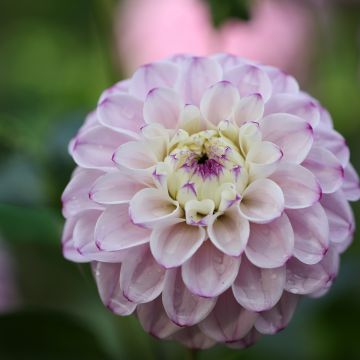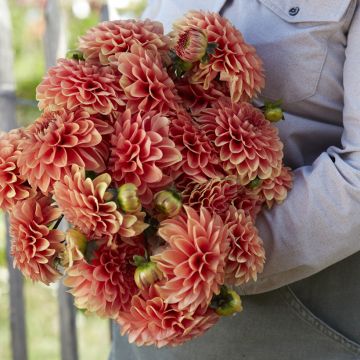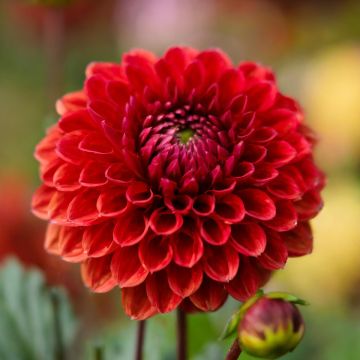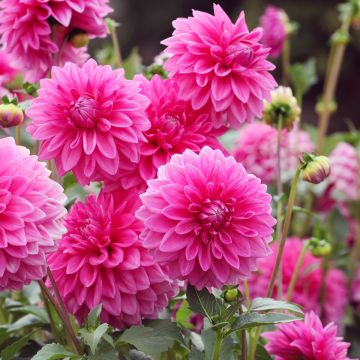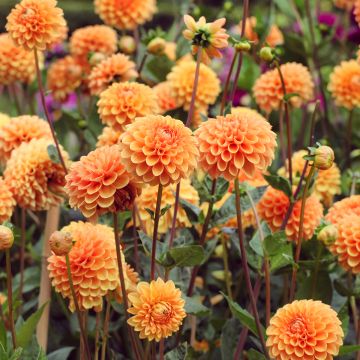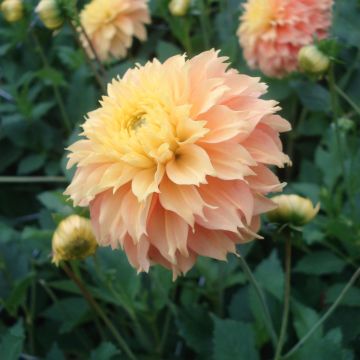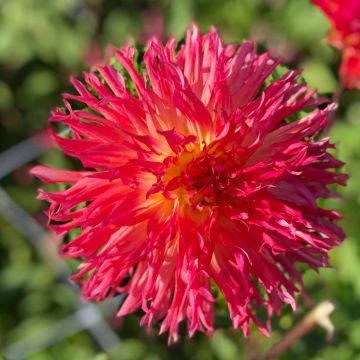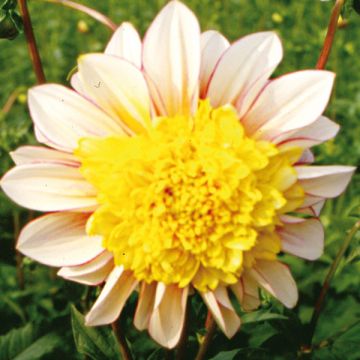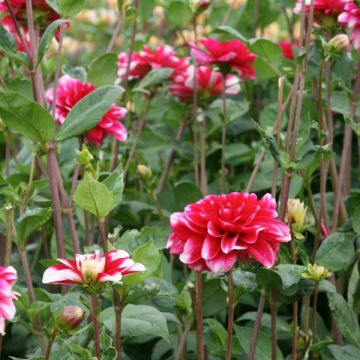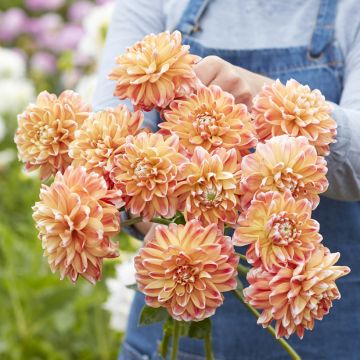

Dahlia Banana Baby
Dahlia Banana Baby
Dahlia Banana Baby
Dahlia
This item cannot be shipped to the selected country
Delivery charge from €5.90
More information
Schedule delivery date,
and select date in basket
This plant carries a 6 months recovery warranty
More information
We guarantee the quality of our plants for a full growing cycle, and will replace at our expense any plant that fails to recover under normal climatic and planting conditions.
From €5.90 for pickup delivery and €6.90 for home delivery
Express home delivery from €8.90.
Does this plant fit my garden?
Set up your Plantfit profile →
Description
Dahlia 'Banana Baby' is a variety of Dahlia known as a 'ball' Dahlia, with a light lemon yellow colour, bright and fresh like a spring sun. The flowers are shaped like large slightly flattened pompoms, arranged in countless alveoli that play with the light and give them relief. The plant, of fairly tall stature, blooms abundantly from summer to frost, on long and sturdy stems, with impeccable endurance in bouquets as well as in borders. Its radiant flowers look stunning with red flowers, acid green euphorbias, and golden plumes of grasses.
Dahlias are part of the Asteraceae family, originally from the high plateaus of Mexico, and bear inflorescences in heads, which we commonly call 'flowers'. At present, the thousands of horticultural varieties obtained by humans have invaded, to our great pleasure, gardens all over the world.
The 'Banana Baby' variety reaches a height of approximately 1.20m (4ft) after 3 to 4 months of cultivation, with a diameter of 50-60cm (20-24in). It is classified among Dahlias of the decorative group, with ball-shaped flowers. In this category, the heads are without a visible centre, and they consist of numerous petals (ligules) regularly arranged and completely rolled up, tubular and never flaring. It includes varieties that form true balls, such as pompoms (diameter less than 6cm (2in)) and balls (diameter greater than 6cm (2in)). The heads of this 'Banana Baby' variety generally measure 10cm (4in) in diameter. The plant has an upright and bushy habit. The flowering of this variety begins in July and ends in October-November. The stems, very branching, long and sturdy, are hollow and the leaves are opposite, pinnatisect, meaning they are divided into 3 or 5 highly toothed lobes. The leaves and stems are a vibrant green here.
To encourage repeat flowering, take care to remove faded flowers, or even better, regularly make large colourful bouquets by combining it with other varieties. 'Banana Baby' produces very bright flowers in bouquets, alongside single or pompom varieties, in white, orange, red or purple. Its long, heavily flowered stems allow for beautiful bouquets late in the season. In borders, this Dahlia pairs perfectly with grasses such as squirreltail barley or tall perennials like Euphorbia characias subsp. wulfenii. Also consider pairing it with Gerbera 'Sweet Sweet Glow' with its vibrant orange flowers.
As a star plant in borders and cottage gardens, Dahlias confidently accompany the most beautiful flowers, but are also appreciated alongside vegetable plants. In Mexico, this tuberous plant was first cultivated as a root vegetable for consumption. However, its poor taste qualities assigned it the status of an ornamental plant. The Dahlia, with its infinitely varied shapes and colours, is now considered one of the most beautiful flowers in the garden.
Report an error about the product description
Plant habit
Flowering
Foliage
Botanical data
Dahlia
Banana Baby
Asteraceae
Dahlia
Cultivar or hybrid
Other Pom-pom Dahlias
Planting and care
The 'Banana Baby' Dahlia is easy to grow in all regions. For abundant flowering, it is good to follow a few simple rules. Plant the tubers in a sunny position after the last frost, rich, fresh, and well-drained soil is perfect. However, stagnant moisture would promote tuber rot. Do not hesitate to amend the soil with compost and sand if necessary. Work the soil deeply and enrich it, for example, with crushed horn or dehydrated blood. Place your tuber and crumble the soil well to fill without air pockets. Your dahlia should be covered with about 6cm (2in) of soil. At the end of planting, water once abundantly, then renew this watering regularly during the first 6 weeks to aid in rooting.
Dahlias are sensitive to cold, so they need to be overwintered. In November, the first frosts cause the foliage to blacken, it's time to dig them up. Carefully remove the tubers. Remove as much soil as possible. Let the foliage dry so that the tubers can replenish their reserves. Then cut the stems to 10cm (4in). Spread your bulbs in a crate on newspaper. Store them frost-free in a dry, cool, and dark place, such as a frost-free garage or an attic, for example. In southern regions, close to the coast, where there are few frosty days per year, it is possible to leave them in place. In this case, simply cover the ground with a layer of leaves or straw for protection.
Planting period
Intended location
Care
This item has not been reviewed yet - be the first to leave a review about it.
Dahlias
Haven't found what you were looking for?
Hardiness is the lowest winter temperature a plant can endure without suffering serious damage or even dying. However, hardiness is affected by location (a sheltered area, such as a patio), protection (winter cover) and soil type (hardiness is improved by well-drained soil).

Photo Sharing Terms & Conditions
In order to encourage gardeners to interact and share their experiences, Promesse de fleurs offers various media enabling content to be uploaded onto its Site - in particular via the ‘Photo sharing’ module.
The User agrees to refrain from:
- Posting any content that is illegal, prejudicial, insulting, racist, inciteful to hatred, revisionist, contrary to public decency, that infringes on privacy or on the privacy rights of third parties, in particular the publicity rights of persons and goods, intellectual property rights, or the right to privacy.
- Submitting content on behalf of a third party;
- Impersonate the identity of a third party and/or publish any personal information about a third party;
In general, the User undertakes to refrain from any unethical behaviour.
All Content (in particular text, comments, files, images, photos, videos, creative works, etc.), which may be subject to property or intellectual property rights, image or other private rights, shall remain the property of the User, subject to the limited rights granted by the terms of the licence granted by Promesse de fleurs as stated below. Users are at liberty to publish or not to publish such Content on the Site, notably via the ‘Photo Sharing’ facility, and accept that this Content shall be made public and freely accessible, notably on the Internet.
Users further acknowledge, undertake to have ,and guarantee that they hold all necessary rights and permissions to publish such material on the Site, in particular with regard to the legislation in force pertaining to any privacy, property, intellectual property, image, or contractual rights, or rights of any other nature. By publishing such Content on the Site, Users acknowledge accepting full liability as publishers of the Content within the meaning of the law, and grant Promesse de fleurs, free of charge, an inclusive, worldwide licence for the said Content for the entire duration of its publication, including all reproduction, representation, up/downloading, displaying, performing, transmission, and storage rights.
Users also grant permission for their name to be linked to the Content and accept that this link may not always be made available.
By engaging in posting material, Users consent to their Content becoming automatically accessible on the Internet, in particular on other sites and/or blogs and/or web pages of the Promesse de fleurs site, including in particular social pages and the Promesse de fleurs catalogue.
Users may secure the removal of entrusted content free of charge by issuing a simple request via our contact form.
The flowering period indicated on our website applies to countries and regions located in USDA zone 8 (France, the United Kingdom, Ireland, the Netherlands, etc.)
It will vary according to where you live:
- In zones 9 to 10 (Italy, Spain, Greece, etc.), flowering will occur about 2 to 4 weeks earlier.
- In zones 6 to 7 (Germany, Poland, Slovenia, and lower mountainous regions), flowering will be delayed by 2 to 3 weeks.
- In zone 5 (Central Europe, Scandinavia), blooming will be delayed by 3 to 5 weeks.
In temperate climates, pruning of spring-flowering shrubs (forsythia, spireas, etc.) should be done just after flowering.
Pruning of summer-flowering shrubs (Indian Lilac, Perovskia, etc.) can be done in winter or spring.
In cold regions as well as with frost-sensitive plants, avoid pruning too early when severe frosts may still occur.
The planting period indicated on our website applies to countries and regions located in USDA zone 8 (France, United Kingdom, Ireland, Netherlands).
It will vary according to where you live:
- In Mediterranean zones (Marseille, Madrid, Milan, etc.), autumn and winter are the best planting periods.
- In continental zones (Strasbourg, Munich, Vienna, etc.), delay planting by 2 to 3 weeks in spring and bring it forward by 2 to 4 weeks in autumn.
- In mountainous regions (the Alps, Pyrenees, Carpathians, etc.), it is best to plant in late spring (May-June) or late summer (August-September).
The harvesting period indicated on our website applies to countries and regions in USDA zone 8 (France, England, Ireland, the Netherlands).
In colder areas (Scandinavia, Poland, Austria...) fruit and vegetable harvests are likely to be delayed by 3-4 weeks.
In warmer areas (Italy, Spain, Greece, etc.), harvesting will probably take place earlier, depending on weather conditions.
The sowing periods indicated on our website apply to countries and regions within USDA Zone 8 (France, UK, Ireland, Netherlands).
In colder areas (Scandinavia, Poland, Austria...), delay any outdoor sowing by 3-4 weeks, or sow under glass.
In warmer climes (Italy, Spain, Greece, etc.), bring outdoor sowing forward by a few weeks.

































